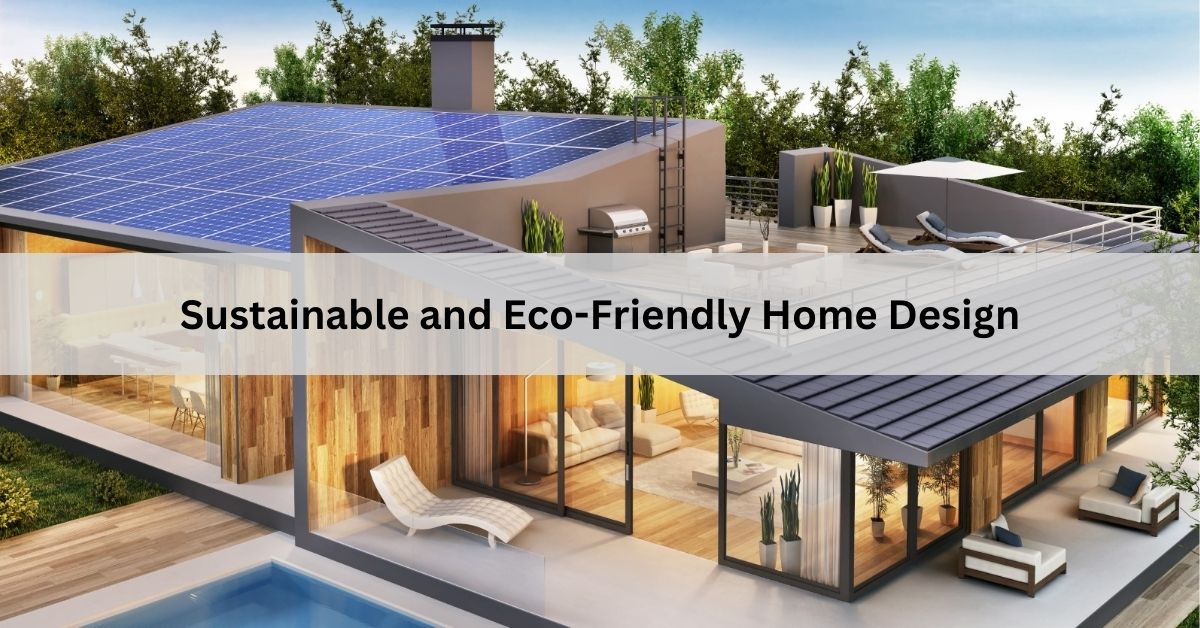
Sustainable and Eco-Friendly Home Design
Introduction
Sustainable and eco-friendly home design is becoming increasingly important as more people recognize the need to reduce their environmental impact. By incorporating sustainable materials, energy-efficient systems, and thoughtful design principles, homeowners can create spaces that are both beautiful and kind to the planet. This guide explores various aspects of sustainable home design, offering practical tips and insights for creating an eco-friendly living environment.
The Importance of Sustainable Home Design
Environmental Benefits
Sustainable home design significantly reduces the carbon footprint of a household. By using renewable resources and minimizing waste, eco-friendly homes help conserve natural resources and reduce pollution. This approach also promotes biodiversity by reducing the need for harmful materials and practices.
Health Benefits
Eco-friendly homes contribute to healthier living environments. Using non-toxic materials and ensuring proper ventilation reduces indoor air pollution, which can improve respiratory health and overall well-being. Natural lighting and the use of plants can also enhance mental health and mood.
Economic Benefits
While the initial investment in sustainable home design may be higher, it can lead to long-term savings. Energy-efficient systems lower utility bills, and durable, high-quality materials reduce maintenance and replacement costs. Additionally, sustainable homes often have higher resale values, making them a wise financial investment.
Key Principles of Sustainable Home Design
Energy Efficiency
Insulation and Windows
Proper insulation and high-quality windows are essential for maintaining a comfortable indoor temperature and reducing energy consumption. Double-glazed windows and insulated walls, roofs, and floors help retain heat during winter and keep the home cool in summer, leading to lower heating and cooling costs.
Renewable Energy Sources
Incorporating renewable energy sources like solar panels and wind turbines can significantly reduce a home’s reliance on fossil fuels. Solar panels, in particular, are becoming more affordable and can provide a substantial portion of a household’s energy needs.
Water Conservation
Low-Flow Fixtures
Installing low-flow fixtures in bathrooms and kitchens can significantly reduce water usage without sacrificing performance. These fixtures use advanced technologies to maintain pressure while using less water.
Rainwater Harvesting
Rainwater harvesting systems collect and store rainwater for use in irrigation, toilet flushing, and even as potable water with proper treatment. This practice reduces demand on municipal water supplies and lowers utility bills.
Sustainable Materials
Recycled and Reclaimed Materials
Using recycled and reclaimed materials in construction and interior design reduces waste and conserves resources. Examples include reclaimed wood for flooring and recycled metal for structural elements.
Non-Toxic Materials
Choosing non-toxic materials, such as low-VOC paints and formaldehyde-free insulation, improves indoor air quality and reduces health risks. Natural materials like bamboo and cork are also excellent choices for sustainable home design.
Passive Design Strategies
Orientation and Layout
Designing a home with the correct orientation can maximize natural light and heat, reducing the need for artificial lighting and heating. South-facing windows in the Northern Hemisphere, for example, can capture more sunlight during winter.
Natural Ventilation
Incorporating natural ventilation strategies, such as cross-ventilation and stack ventilation, helps regulate indoor temperatures without relying on mechanical systems. Properly placed windows, vents, and open floor plans facilitate the free flow of air.
Sustainable Interior Design Tips
Eco-Friendly Furniture
Choose furniture made from sustainable materials like bamboo, reclaimed wood, or recycled metal. Opt for pieces that are durable and timeless, reducing the need for frequent replacements.
Green Decor
Incorporate plants into your home decor to improve air quality and add a touch of nature. Choose natural fibers like organic cotton, wool, and hemp for textiles and upholstery.
Efficient Lighting
Use energy-efficient lighting solutions, such as LED bulbs, which consume less electricity and have a longer lifespan than traditional incandescent bulbs. Consider installing dimmer switches and motion sensors to further reduce energy usage.
Case Studies of Sustainable Homes
The Passive House
A Passive House is a rigorous, voluntary standard for energy efficiency in a building, which reduces its ecological footprint. It results in ultra-low energy buildings that require little energy for space heating or cooling. These homes are designed with super-insulated walls, high-performance windows, and airtight construction to maintain comfortable temperatures year-round.
The Earthship
Earthships are off-grid homes built from natural and recycled materials. They use passive solar heating and cooling, water harvesting, and contained sewage treatment to create a self-sustaining living environment. Earthships are designed to be environmentally friendly and reduce reliance on external resources.
The Tiny House
Tiny houses are compact, often mobile, homes designed to minimize environmental impact. They use fewer materials and require less energy for heating and cooling. Many tiny houses incorporate sustainable features like solar panels, composting toilets, and rainwater harvesting systems.
Future Trends in Sustainable Home Design
Smart Home Technology
Smart home technology is playing a crucial role in sustainable home design. Automated systems can optimize energy usage by controlling lighting, heating, and cooling based on occupancy and time of day. Smart irrigation systems can also reduce water waste by adjusting to weather conditions.
Green Building Certifications
Green building certifications, such as LEED (Leadership in Energy and Environmental Design) and BREEAM (Building Research Establishment Environmental Assessment Method), are becoming more popular. These certifications provide frameworks for designing, constructing, and operating sustainable buildings, ensuring that homes meet high environmental standards.
Biophilic Design
Biophilic design integrates natural elements into the built environment, promoting a connection with nature. This approach includes features like green roofs, living walls, and indoor gardens, which enhance well-being and reduce stress.
Conclusion
Sustainable and eco-friendly home design offers numerous benefits, from reducing environmental impact and enhancing health to providing long-term economic savings. By embracing principles such as energy efficiency, water conservation, and the use of sustainable materials, homeowners can create beautiful, functional spaces that contribute to a healthier planet. As technology advances and awareness grows, sustainable home design will continue to evolve, making eco-friendly living more accessible and impactful.
You May Also Like

Cataz Net – Your Guide to Free Movie and TV Streaming
August 7, 2024
The Ultimate Guide to www.seattlesportsonline.com/ – Your Go-To Source for Seattle Sports
August 8, 2024
